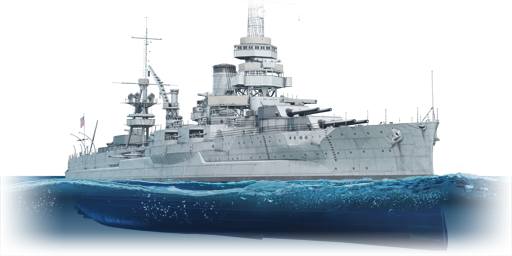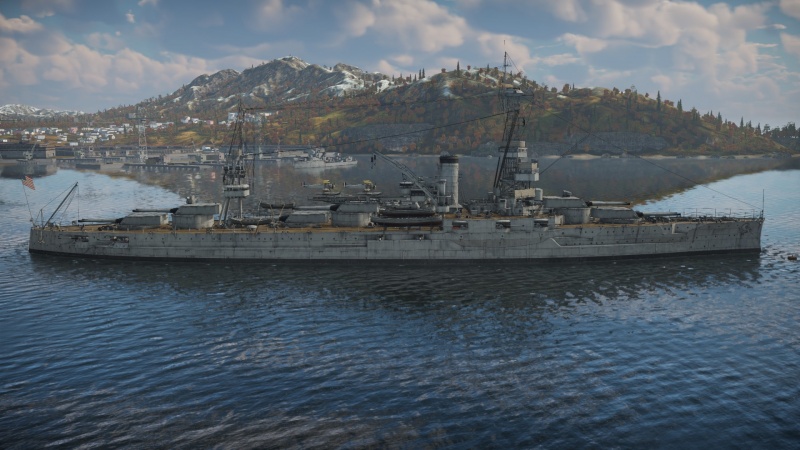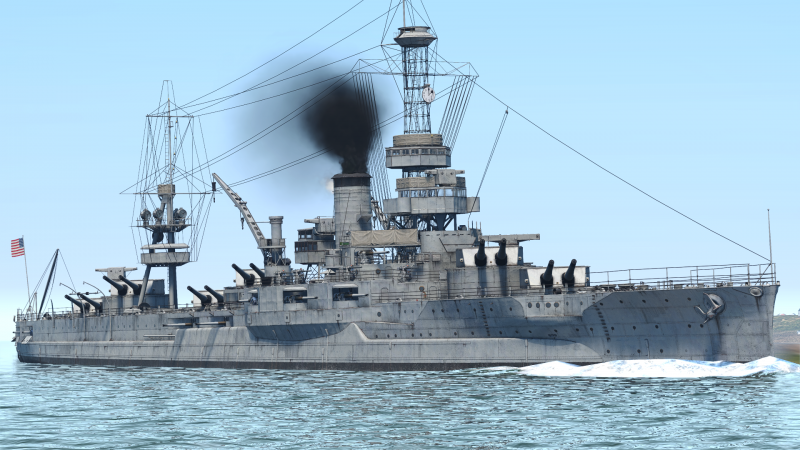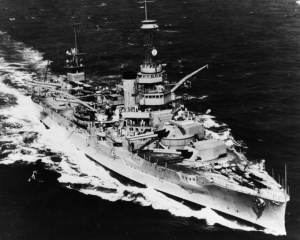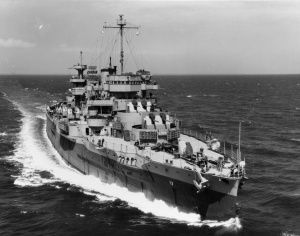USS Wyoming
Contents
Description
Essentially an enlarged version of the previous Florida-class battleship, itself a repeat of the Delaware-class, the Wyoming-class battleship is the final classic dreadnought of the US Navy and the last American battleship to be armed with 12-inch cannons. The class presents a substantial improvement over its predecessor, notably being the first American battleship to utilize torpedo bulkheads.
The two ships of the class, Wyoming and Arkansas, would later see extensive service in both world wars. The sisters would serve under different roles during World War II - Wyoming was demilitarized to comply with the 1930 London Naval Treaty and served as a training ship and later an anti-air training ship throughout the war, while Arkansas continued her career as a capital ship and served in both the Atlantic and Pacific theatre.
Introduced in Update "Red Skies", the USS Wyoming in War Thunder is in her 1927 configuration, representing her peak performance as a dreadnought prior to her demilitarization. In this refit, she receives a torpedo belt, reinforced deck armour, more efficient oil-fired boilers, and some 3-inch anti-aircraft guns. While the Wyoming is largely similar to other classic dreadnought in terms of gameplay, she stands out for her survivability, serviceable anti-air defense, and the excellent penetration offered by her main battery for its calibre.
General info
Survivability and armour
The USS Wyoming is well armoured for an early battleship, with a distributed armour scheme, and quite survivable. She has a main belt 11 inches thick, angled at 2° to increase the thickness of the armour. It can be expected to withstand hits from other 12-inch-armed battleships of the rank, and the smaller 283 mm guns of the early German battleships. The armour begins to have troubles when facing later battleships with larger than 14-inch guns, although if angled the armour can hold off some hits from heavier calibres. Above and below the main belt, the armour drops to 9 inches and drops to a 1-inch plate well below the waterline.
USS Wyoming is in her 1927 refit, and gains access to torpedo bulges which protect against 250 kg warheads and below. This will defeat commonly seen torpedoes like the American Mk.15 but will struggle against heavier torpedoes such as the German G7a and provide negligible protection against the Japanese Type 93 Long Lance and every effort should be made to avoid these.
The turrets are well armoured with 12-inch plates fore and aft, with the front face of the turrets angled at 38° to increase effectiveness. The sides have a thickness of 8 inches and the barbettes have a thickness of 11 inches of armour. The turret roof has 7.7 inches of armour and will protect from all but large calibre rounds at extreme ranges and angles. The casemates have 6.5 inches of armour protecting them, and smaller plates behind the casemate lead down to the machinery spaces. The main armoured deck has a thickness of 4.5 inches and the citadel has two layers of roof armour, a plate of 4 inches and a smaller 1.5-inch plate beneath, directly above the magazines.
Speaking of the magazines, they're positioned slightly beneath the waterline and under layers of armour, so from most near-peer engagements the magazines are relatively unlikely to be hit. Higher rank battleships and battlecruisers such as the IJN Hyuga, SMS Bayern, or HMS Hood will have a much easier time penetrating the citadel and doing critical damage with the larger bursting charges higher calibre shells are able to support, so sitting stationary and trading blows with the later ships is not recommended.
Mobility
The USS Wyoming, like many other early dreadnought-type battleships, reaches a top speed of 21.0 kn. While it is average for a battleship, cruisers and destroyers will easily beat her to objectives, and captains of Wyoming should not expect to be able to capture multiple objectives in most battles. Similarly, in the naval Enduring Confrontation mode, it will take Wyoming a considerable amount of time to cover distance compared to battlecruisers such as HMS Hood or the Scharnhorst. USS Wyoming will take about 40 seconds to steam to flank speed from a standstill, and around 1 minute to stop from flank. It takes Wyoming around 4 seconds to respond to rudder inputs, and the turning circle is mediocre for a 27,680-ton displacement battleship. Her speed will fall to 27 km/h (15 knots) while in a turn, and it is recommended for captains of Wyoming to plan their course well in advance, as she will not respond quickly nor is capable of avoiding terrain quickly.
| Mobility Characteristics | |||
|---|---|---|---|
| Game Mode | Upgrade Status | Maximum Speed (km/h) | |
| Forward | Reverse | ||
| AB | |||
| Upgraded | 45 | 13 | |
| RB/SB | |||
| Upgraded | 39 | 11 | |
Modifications and economy
Armament
Primary armament
The USS Wyoming has 12 x 12-inch cannons, split into 6 double mounts, two forward, two mid and two aft. The turrets have a reasonably quick traverse rate of 4°/second. This allows Wyoming to react to threats quicker, for example it takes USS Wyoming half the time to swing the guns around from one broadside to another as more heavily armed ships such as USS Arizona or HMS Hood. The tried and true double mount for the 12-inchers means that USS Wyoming has a respectable reload of 28.18 seconds with a fully upgraded crew. This is slightly faster than the British ships armed with 12-inch guns, and of course most of the ships armed with 13.5-inchers and up. This can give a slight advantage in skirmishes between capital ships, though Captains should be mindful that the 305 mm guns of the Imperial German ships will easily outpace the Wyoming's reload, with a 20 second reload with max crew level.
USS Wyoming has access to two shell types: the 12-inch CL.B HE, and the 12 inch Mk.15 APC. Wyoming gets access to no other type of shells, with the notable lack of SAP, similar to other American capital ships.
The Cl.B HE round has an explosive filler of 33.25 kg TNT eq, which puts the USS Wyoming firmly in the middle of the pack compared to 12-inch battleships from other nations. With more filler than contemporary German and Italian battleships, but less than the Japanese and British, Wyoming will do appreciable damage to lightly-armoured ships such as destroyers and light cruisers, and the extra barrels in the broadside compared to the British in particular can allow more explosives to hit home. The HE shell begins to lack punch when fighting larger light cruisers and of course heavy cruisers, therefore the AP shell should be the shell of choice for these more heavily-armoured targets.
The AP shell has a substantial punch with 562 mm of pen at 1,000 m, but the filler of 11.11 kg is lacklustre. it is recommended for captains of USS Wyoming to prioritize destroying modules such as turrets, shell elevators and of course the enemy magazines, as the shell simply lacks the filler to do substantial damage to large numbers of crew like the high filler SAP shells that some other capital ships use in high rank naval battles. It is recommended to inspect commonly seen enemy ships and ascertain the position of the magazines to precisely aim at them in all engagements with enemy capital ships, as otherwise it can take many salvoes for Wyoming to whittle down the crew count of the enemy vessel. This shell is not suited for engaging lightly-armoured enemy vessels, as in the 0.035 seconds it takes after the fuse is activated for the shell to explode, the sheer velocity carried by the shells will usually carry them clean through smaller ships and then proceed to explode harmlessly in the open air. HE shells should be used to dispatch lightly-armoured vessels.
| Penetration statistics | |||||||
|---|---|---|---|---|---|---|---|
| Ammunition | Type of warhead |
Penetration @ 0° Angle of Attack (mm) | |||||
| 1,000 m | 2,500 m | 5,000 m | 7,500 m | 10,000 m | 15,000 m | ||
| Cl.B HE | HE | 68 | 68 | 68 | 68 | 68 | 68 |
| Mk.15 APC | APC | 562 | 501 | 416 | 348 | 293 | 221 |
| Shell details | ||||||||||||
|---|---|---|---|---|---|---|---|---|---|---|---|---|
| Ammunition | Type of warhead |
Velocity (m/s) |
Projectile mass (kg) |
Fuse delay (s) |
Fuse sensitivity (mm) |
Explosive mass (TNT equivalent) (kg) |
Ricochet | |||||
| 0% | 50% | 100% | ||||||||||
| Cl.B HE | HE | 823 | 335.65 | 0 | 0.1 | 33.25 | 79° | 80° | 81° | |||
| Mk.15 APC | APC | 884 | 394.62 | 0.035 | 17 | 11.11 | 48° | 63° | 71° | |||
Secondary armament
USS Wyoming is equipped with 16 x 5-inch single mount casemate guns. They're positioned 8 per side, and this gives the Wyoming a maximum broadside of 8 guns as well. This provides supplementary fire, mostly effective against destroyers and coastal vessels, but with the possibility of some light damage against heavier opponents as well.
The guns have a maximum reload of 6.7 seconds when on ace crew, which combined with the healthy number of guns means that captains of USS Wyoming are capable of keeping a consistent stream of shells going downrange. The APC is the recommended shell, as it contains 10 grams less filler, but with much better penetration at all ranges. The slight decrease in post-penetration damage is more than made up for in the extra penetration, especially when the range opens up slightly, as even at 5 km the SAP shell may begin to struggle against the armour of later light cruisers.
| Penetration statistics | |||||||
|---|---|---|---|---|---|---|---|
| Ammunition | Type of warhead |
Penetration @ 0° Angle of Attack (mm) | |||||
| 1,000 m | 2,500 m | 5,000 m | 7,500 m | 10,000 m | 15,000 m | ||
| Mk.15 common | Common | 114 | 94 | 68 | 50 | 38 | 26 |
| 5 inch APC | APC | 191 | 157 | 115 | 84 | 64 | 44 |
| Shell details | ||||||||||||
|---|---|---|---|---|---|---|---|---|---|---|---|---|
| Ammunition | Type of warhead |
Velocity (m/s) |
Projectile mass (kg) |
Fuse delay (s) |
Fuse sensitivity (mm) |
Explosive mass (TNT equivalent) (g) |
Ricochet | |||||
| 0% | 50% | 100% | ||||||||||
| Mk.15 common | Common | 960 | 22.68 | 0.005 | 6 | 780 | 47° | 60° | 65° | |||
| 5 inch APC | APC | 960 | 22.68 | 0.015 | 5 | 770 | 48° | 63° | 71° | |||
Anti-aircraft armament
USS Wyoming gets access to a heavy AA battery of 8 3-inch/50 Mk.10 guns, arranged in single mounts 4 per side around the bridge amidships. USS Wyoming is in her 1927 refit, and as this is well before the advent of HE-VT shells, the 3-inchers only gains access to time fused shells. It is recommended to upgrade "AAA gunner accuracy" and "Distance fuze set accuracy" crew skills to increase the efficacy of the AA battery. Once upgraded, captains can expect a steady flow of destroyed aircraft, usually against aircraft flying in a straight or predictable path. As Wyoming lacks any smaller 40 or 20 mm guns, aircraft taking evasive action are unlikely to be hit.
Usage in battles
USS Wyoming is a respectable ship for her captains. She is well optimized for sinking lightly-armoured ships such as destroyers and light cruisers due to the volume of high explosive shells she can send downrange with her 12-gun broadside, and a concentrated salvo will quite often cause lightly armoured vessels to heel out of the battle line and quite often take on catastrophic amounts of water.
USS Wyoming is also quite competent when engaging enemy capital ships, as her longer barrels compared to USS North Dakota impart extra penetration to her armour-piercing shells, allowing her to engage most heavy enemy ships, although particular attention should be made to watch for more advanced vessels such as SMS Bayern or HMS Hood, as these ships will be quite dangerous to captains of Wyoming.
It is recommended to avoid coming to very close range of enemy ships, as USS Wyoming uses a distributed armour scheme and has much lower levels of armour past the belt, allowing even heavy cruisers to penetrate at close ranges. Therefore captains of Wyoming should attempt to keep the range in their favour, only closing the range if there is low presence of enemy capital ships. Captains of Wyoming should also be wary of enemy torpedoes, as her manoeuvrability is a bit lacklustre, therefore a careful eye should be kept for torpedo trails and preemptive action taken. It may be tempting to rely on the torpedo protection, but that should be a final measure rather than the go-to.
USS Wyoming serves as a reasonably strong battleship for the United States bluewater fleet, with good penetration and slightly above average rate of fire, along with substantial protection, especially as one of the earliest battleships in-game.
Pros and cons
Pros:
- Large main battery of 12 guns housed in six turrets
- Can easily fire full broadside
- Great secondary battery
- Great all-around protection around her citadel, practically immune to cruisers and some battleships while at range
Cons:
- Slow and sluggish, as with the other dreadnoughts
- Lacks coal bunkers for extra internal armour
- Mediocre AA capability compared to later refit ships
- Only has access to HE and AP shells, no semi-armour-piercing.
- Lower calibre guns compared to the super-dreadnoughts
History
USS Wyoming (BB-32) was the lead ship of the Wyoming-class battleship of the United States Navy. Her design is an improvement over the previous Florida class, featuring an additional main turret and being the first American battleship to utilize torpedo bulkheads. Her class is the only American battleship to feature six main turrets and were the last to be armed with 12-inch (305 mm) guns. Wyoming served in both world wars, first as a battleship in World War I, then as a training ship in World War II, before being scrapped in 1947.
Construction and World War I services
Wyoming was laid down at the William Cramp & Sons shipyard in Philadelphia on February 9, 1910 and launched on May 25, 1911. She was then completed and commissioned on September 25, 1912. During this time, Wyoming was assigned to Battleship Division 9 and conducted various trainings in and around the Caribbean.
After the United States entered World War I in 1917, Wyoming sailed east to join the British Grand Fleet at Scapa Flow. The first wartime mission undertaken by Wyoming was on February 6, 1918, in which the battleship was to escort a convey to Stavanger, Norway. The mission was a success, apart from the false alarm of German U-boats. Wyoming patrolled in the North Sea for the next few months, watching for a sortie by the German High Seas Fleet. On June 30, Wyoming and the rest of the 6th Battle Squadron conducted a minelaying operation in the North Sea until July 2. In December of the same year, the USS Wyoming was carrying Woodrow Wilson to the peace negotiations in Paris.
Interwar years and conversion into training ship
A year after the war ended in 1919, Wyoming underwent her first overhaul to remove some unnecessary 5-inch (127 mm) mounts. During the 1920s, Wyoming underwent two modernization overhauls, first between 1925-26 to install a 3-inch (76 mm) anti-air suite and reinforce her deck armour, then again in late 1926-27 to replace her coal-fired boilers with an oil-fired boiler (leftover from ships cancelled after the Washington Naval Treaty), an addition of torpedo bulges, and a sea plane catapult on her midship turret.
In 1931, Wyoming was demilitarized and converted into a training ship in accordance with the London Naval Treaty. During this conversion, half of her main turrets along with her belt armour and torpedo bulge were removed. She later received the new designation AG-17 and primarily served as an gunnery training ship prior to World War II.
World War II and aftermath
When the United States became involved in World War II, the US Navy considered reverting Wyoming back to its former battleship state, though they later decided against the plan after reconsidering the ship's usefulness as an anti-air gunnery trainer. During the war, Wyoming would receive several refits to better accommodate her role as an anti-air training ship.
Her first refit was completed around 1942, there all of her remaining 5-inch sponson guns were replaced with various newer 5-inch Mk.12 dual-purpose guns in various configurations (four single open mounts, two single enclosed mounts, and one twin mount). Her second refit was completed in 1944, replacing all of her remaining 12-inch turrets with dual-mount 5-inch turrets. She also received several minor refits throughout this period, including the addition of a target drone catapult, a large number of Bofors and Oerlikon autocannons in various mounts, and various fire control systems.
During her wartime career between 1942 - 1945, she trained over 35,000 gunners and officers, and fired over 1,700,000 rounds of ammunition of all types - the largest amount fired from any US warship at that time. She was nicknamed "Chesapeake Raider" by her crew due to primarily sailing in and out of the Chesapeake Bay during her gunnery session. Other than her training duties, Wyoming was also used as a testing ground for new technology (such as new fire control systems). One of the last group of her crew were then-Ensign Jimmy Carter, the future President of the United States, who came on board in summer of 1946.
USS Wyoming was decommissioned following the end of the war on August 1, 1946. Her crew were transferred to USS Mississippi (AG-128), another battleship that was converted for anti-air training and experimental purposes, and she was sold for scrap on October 30, 1947.
Media
- Skins
See also
External links
- [Devblog] USS Wyoming (BB-32): high calibre romance
- Dictionary of American Naval Fighting Ships's entry of the USS Wyoming (BB-32/AG-17)
| William Cramp & Sons Shipbuilding Co. | |
|---|---|
| Gun Destroyers (DD) | |
| Clemson-class | USS Barker |
| Cruiser, Light (CL) | |
| Omaha-class | USS Trenton |
| Battleships (BB) | |
| Wyoming-class | USS Wyoming |
| USA battleships | |
|---|---|
| Delaware-class | USS North Dakota |
| Wyoming-class | USS Wyoming · USS Arkansas |
| New York-class | USS Texas |
| Nevada-class | USS Nevada |
| Pennsylvania-class | USS Arizona |
| New Mexico-class | USS Mississippi |


